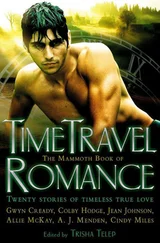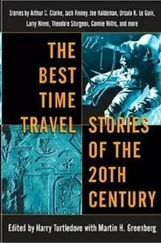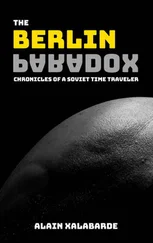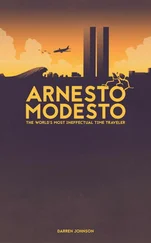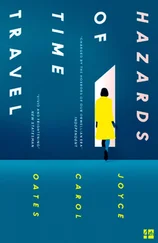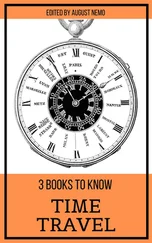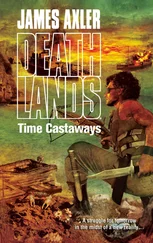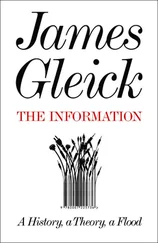James Gleick - Time Travel
Здесь есть возможность читать онлайн «James Gleick - Time Travel» — ознакомительный отрывок электронной книги совершенно бесплатно, а после прочтения отрывка купить полную версию. В некоторых случаях можно слушать аудио, скачать через торрент в формате fb2 и присутствует краткое содержание. Год выпуска: 2016, Издательство: Knopf Doubleday Publishing Group, Жанр: Старинная литература, на английском языке. Описание произведения, (предисловие) а так же отзывы посетителей доступны на портале библиотеки ЛибКат.
- Название:Time Travel
- Автор:
- Издательство:Knopf Doubleday Publishing Group
- Жанр:
- Год:2016
- ISBN:нет данных
- Рейтинг книги:5 / 5. Голосов: 1
-
Избранное:Добавить в избранное
- Отзывы:
-
Ваша оценка:
- 100
- 1
- 2
- 3
- 4
- 5
Time Travel: краткое содержание, описание и аннотация
Предлагаем к чтению аннотацию, описание, краткое содержание или предисловие (зависит от того, что написал сам автор книги «Time Travel»). Если вы не нашли необходимую информацию о книге — напишите в комментариях, мы постараемся отыскать её.
Time Travel — читать онлайн ознакомительный отрывок
Ниже представлен текст книги, разбитый по страницам. Система сохранения места последней прочитанной страницы, позволяет с удобством читать онлайн бесплатно книгу «Time Travel», без необходимости каждый раз заново искать на чём Вы остановились. Поставьте закладку, и сможете в любой момент перейти на страницу, на которой закончили чтение.
Интервал:
Закладка:
Their house is in Bloomsbury, “happily situated between a sandpit and a chalk pit,” which means they can walk to the British Museum. *3In turn-of-the-century London, this was an institution like none other in the world: a treasure house of antiquities from everywhere England had sent its seaborne colonizers and plunderers. It had the Elgin Marbles, named for the Scottish earl who made off with them from the Acropolis of Athens. It had the only surviving original of Beowulf. Visitors could walk into a gallery and examine the Rosetta Stone on a plinth. The museum was a portal to the past, a time gate through which ancient artifacts poked their age-worn surfaces into modernity: a bronze head from Smyrna, mummy cases from Egypt, winged sphinxes of sandstone, drinking vessels looted from Assyrian tombs, and hieroglyphs preserving secrets in a lost language.
If Cyril, Robert, Anthea, and Jane were getting an education in the perplexities of time—past and present jumbled together in odd ways, cultures misunderstanding one another across a gulf of ages—so were England’s adults. Besides museums there were shops trading in relics of the past—“curiosities” and “antiquities”—especially on Wardour Street, Monmouth Street, and Old Bond and New Bond Streets. These physical objects, worn or broken by the years, were like bottles containing messages written by our ancestors, to tell us who they were. “Antiquities are Historie defaced, or some remnants of History, which have casually escaped the shipwrack of time,” Roger Bacon had said. By 1900, London had surpassed Paris, Rome, Venice, and Amsterdam as the world’s center of trade in antiquities. Nesbit’s band of children walk past a curiosity shop near Charing Cross and there discover a small red charm, an amulet of shiny stone. It is trying to tell them something. It has magic powers. Before they know it, they’re on their way to that other country, the Past.
First, a few scientific-sounding words to help them along:
“Don’t you understand? The thing existed in the Past. If you were in the Past, too, you could find it. It’s very difficult to make you understand things. Time and space are only forms of thought.”
Of course Nesbit had read The Time Machine . Late in the story, her heroes do dart briefly into the future (using the British Museum as a portal). They find a sort of socialist utopia—all clean and happy and safe and orderly, perhaps to a fault—and encounter a child named Wells, “after the great reformer—surely you’ve heard of him ? He lived in the dark ages.” With that brief exception, their real adventures take them backward into the Past (always reverently capitalized). They find themselves in Egypt, where children wear no clothes to speak of and tools are made of flint, because no one has heard of iron. They go to Babylon and meet the Queen in her palace of gold and silver, with flights of marble steps and beautiful fountains and a throne with embroidered cushions. She takes time out from throwing people in jail to entertain the time travelers with cold drinks. “I’m simply dying to talk to you, and to hear all about your wonderful country and how you got here, and everything, but I have to do justice every morning. Such a bore, isn’t it?” Then it’s off to another ancient land, Atlantis: “Great continent—disappeared in the sea. You can read about it in Plato.” They find blue sea sparkling in sunlight, white-capped waves lapping marble breakwaters, and the people riding around on great hairy mammoths—not as mild looking as the elephants they were accustomed to seeing at London’s zoo.
Archeology catalyzed imaginative literature. Nesbit didn’t intend to invent a time-travel subgenre, because she couldn’t see into the future, but she did just that. Meanwhile, also in 1906, Rudyard Kipling published a book of historical fantasies called Puck of Pook’s Hill, with swords and treasures and children transported through the years by the magic of storytelling. C. S. Lewis read Nesbit’s Amulet when he was a boy in Ireland: “It first opened my eyes to antiquity, the ‘dark backward and abysm of time.’ ” The road that started here led fifty years later to Peabody’s Improbable History, the television cartoon series that began appearing on The Rocky and Bullwinkle Show. Mr. Peabody, the time-traveling beagle, and his boy, Sherman, take their WABAC Machine back to the construction of the pyramids at Giza, and also to visit Cleopatra, King Arthur, the emperor Nero, Christopher Columbus, and Isaac Newton, at the foot of his apple tree. Anachronism is rampant. The pedagogy is joyously imperfect. *4Later still came the cult film Bill and Ted’s Excellent Adventure: history “rewritten by two guys who can’t spell.” Some time-tourists go to ogle, others to study history.
All these children—Cyril, Robert, Anthea, Jane, and the boy Sherman—want to go back and see the famous names enacting their famous stories. They serve as proxies for our desire to know what really happened. That desire seems to burn more fiercely when it is partially satisfied. The better that technology gets at capturing and representing our experience of the present, the more we suffer from the fog of ignorance that divides us from lost times. Progress in visualization shows us what we’re missing. In Nesbit’s time, statues and painted portraits were giving way to photographs. There was a magic in the way they froze an instant of time. Later, the dog Mr. Peabody was of course expert in the new medium of television. Nowadays every modern historian and biographer has felt the desire to send a video camera into the past—to Newton’s garden or King Arthur’s court—if an actual time machine is not available.
“I’ve always felt a wonder at old photographs,” says Simon Morley. He is a sketch artist, working in advertising in New York, and he is the narrator of Time and Again, a 1970 novel (illustrated with sketches and vintage photographs) by Jack Finney, a former New York ad man himself. *5Simon deeply feels the inaccessibility of the past, once alive, now lost, taunting us with the few objects and images that survive.
Maybe I don’t need to explain; maybe you’ll recognize what I mean. I mean the sense of wonder, staring at the strange clothes and vanished backgrounds, at knowing that what you’re seeing was once real. That light really did reflect into a lens from these lost faces and objects. That these people were really there once, smiling into a camera. You could have walked into the scene then, touched those people, and spoken to them. You could actually have gone into that strange outmoded old building and seen what now you never can—what was just inside the door.
It’s not just photographs. Someone appropriately sensitized, like Simon, can see the fingers of the past pressing through the cracks of all his existence. In a dense old city like New York, the past is in the stones and the bricks. The relic that triggers Simon’s time travels will turn out to be a residential building—not just any apartment house, but a famous one, the Dakota: “like a miniature town…gables, turrets, pyramids, towers, peaks…acres of slanted surfaces shingled in slate, trimmed with age-greened copper, and peppered with uncountable windows, dormer and flush; square, round, and rectangular; big and small; wide, and as narrow as archers’ slits.” This will be his portal.
The conceit of Time and Again is that time travel to the past can be accomplished with no machinery, no magic, but merely a trick of the mind, a bit of self-hypnosis. If the right subject, a sensitive person like Simon, can rid his memory and purge his surroundings of every trace of the past century, he can translate himself by an act of will into, for example, the year 1882. First he must get into the mood: “There are no such things as automobiles….There are no planes, computers, television, no world in which they are possible. ‘Nuclear’ and ‘electronics’ appear in no dictionary anywhere on the face of the earth. You have never heard the name Richard Nixon…or Eisenhower…Adenauer…Stalin…Franco…General Patton.”
Читать дальшеИнтервал:
Закладка:
Похожие книги на «Time Travel»
Представляем Вашему вниманию похожие книги на «Time Travel» списком для выбора. Мы отобрали схожую по названию и смыслу литературу в надежде предоставить читателям больше вариантов отыскать новые, интересные, ещё непрочитанные произведения.
Обсуждение, отзывы о книге «Time Travel» и просто собственные мнения читателей. Оставьте ваши комментарии, напишите, что Вы думаете о произведении, его смысле или главных героях. Укажите что конкретно понравилось, а что нет, и почему Вы так считаете.


